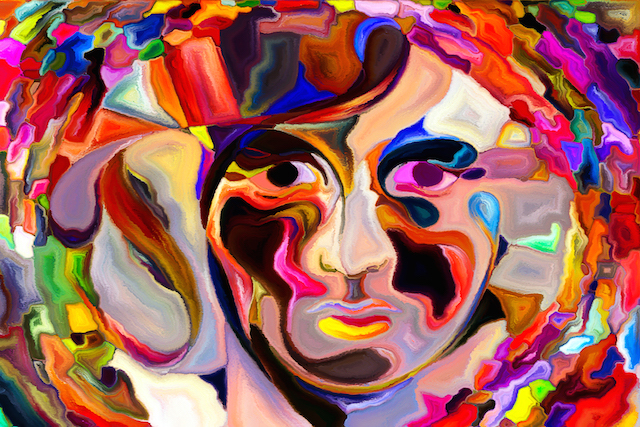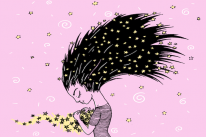
“I vow to let go of all worries and anxiety in order to be light and free.” ~Thich Nhat Hanh
There is so much noise and overwhelm these days it’s almost impossible to not feel crippling anxiety on a regular basis.
With a march of commitments, appointments, and obligations that never seem to end, we’re a nation of chronically stressed and overwhelmed.
We often spend our lives in a rush, running on autopilot, completing task after task until we finally collapse into bed utterly exhausted. Amidst the noise and demands our minds are scattered, in a perpetual state of thinking, planning, regretting, and worrying.
Hence the anxiety—a normal response considering how little time we spend in our bodies, grounded, connected, and still.
I’ve struggled with anxiety for as long as I can remember. My sensitive nature and rough childhood undoubtedly shaped me. Chronic fear and anxiety manifested as perfectionism, people-pleasing, and perpetual shame. I didn’t feel that I belonged with my family, friends, or the world.
I learned to treat myself just as badly as others did. I was my worst critic and abuser. I felt broken, unable to navigate these huge feelings of fear and shame on my own. Surrounded by negativity, aggression, and chaos, I closed my heart and disconnected from myself.
Motherhood cracked me back open with a force I was not ready for. I wanted to give my children the kind of love and safety I was deprived of as a child, but the stress of raising three little kids was overwhelming, and anxiety kicked in full force. It took me years to recalibrate my mind, reconnect with myself, and find my footing again.
There’s a gentle way out of habitual stress and overwhelm, but it requires our full presence and attention, and developing new habits that will help us heal and change.
With practice, we can transform our lives through small, incremental changes that can shift our lives away from chronic stress and anxiety toward a more adaptable and peaceful way of living.
While we have little control over most things in life, certain things we do have control over, and that’s what we need to focus on.
There are many body-based ways we can control our stress and reduce cortisol levels, like cutting down on caffeine, alcohol, sugar, and refined carbs, and getting quality sleep and exercise. But those alone will not shift you out of anxiety. You have to tackle what goes on in your mind as well. Here’s how.
1. Carve out time for stillness and flow.
To counteract our incredibly fast pace of living, we must carve out time in our busy schedules to slow down and immerse ourselves in activities that give us moments of flow, peace, and space.
Our days are filled with noise and events that require our constant attention. Therefore, we have to be deliberate in setting aside time for stillness, nature, and creativity, time for things that nourish and replenish us.
I reconnect with stillness and flow through yoga, art, and nature. Whether holding a pose, drawing, or walking through the woods, I find the silence and slow pace soothing and comforting. I forget all my troubles and find bliss in the sensations I get to experience: the sounds, the smells, the beauty around me.
It’s like my existence is temporarily suspended as I immerse myself in an act of awe, wonder, or creation. It’s incredibly rewarding and relaxing.
Create daily rituals that purposely slow you down and shift your attention inward. Incorporate those moments in your self-care routine. Unplug from the busyness and give yourself the luxury of solitude and stillness.
Plan some alone time every day, if only for fifteen minutes. Spend this time on your own—in your garden, on a mat, in bed—and bask in the space and joy of solitude and silence. Reignite your inner sacred space and nourish yourself in a new, rewarding way.
2. Befriend your mind.
We spend most of our day on autopilot, and that’s by design. At the same time, if we don’t pay attention to where our mind goes and what it does, we’re just allowing habitual thoughts and behaviors to lead our lives, for better of worse.
I used to be quite oblivious to what was happening inside my head. This lack of deep self-awareness was alienating and affected every aspect of my life, especially my relationships.
For example, having never learned how to handle conflict constructively, I would mindlessly react from pain and shame (yell, shut down, get defensive or overly emotional), which only distanced me from others and perpetuated problems.
Feeling guilty and ashamed, I’d then ruminate on unresolved conflicts and past hurts, fueling my anxiety and making me feel depressed, helpless, and unable to move past them. Still, I didn’t understand why everything seemed to always work against me, and why I struggled so much relating to others despite succeeding in school and at work.
Eventually, I realized that living in a perpetual state of worrying about the future while resenting what had happened to me in the past was self-destructive and harmful to others as well. Living in my head was perpetuating my own anxiety and slowly destroying my life. So, I finally decided to try mindfulness in order to find some peace and learn to live differently.
Mindfulness brought clarity and pushed my unconscious beliefs and patterns to the surface. I now saw how having grown up around chronic anger, chaos, and pain and without much love and support led me to internalize a lot of shame, fear, and distrust. And that’s what was quietly in charge of my life—until now!
With mindfulness, I learned to observe my thoughts and where they lead me, see where I self-destruct and work against my values and goals. And instead of judging myself harshly for my weaknesses and failures, mindfulness taught me to take ownership of my actions, and my life; that I have a choice to do things differently; that I’m not damaged, I just don’t have the skills—yet. In time, mindfulness broke the shame, pain, and anxiety spiral I was in, and allowed recovery.
Mindfulness is empowering; it’s the opposite of anxiety. Instead of worrying and frantically trying to control our environment, it teaches us to be open, slow down, and observe what is happening within us and around us, and to respond authentically instead of reacting habitually out of shame or fear.
This deepened awareness allows us to fully experience the world in all its richness. Slowly, we awaken to life’s small pleasures, dropping chronic worry and endless distractions from taking over our lives. We develop the freedom to think and act differently, build new habits, deal with difficult emotions, overcome our struggles, and learn to flow with life as it unfolds.
3. Practice grateful living.
Our minds are biased toward negativity, and we habitually focus on problems giving them much more attention than is necessary, inducing anxiety in the process. If left unchecked this can put a negative spin on our day, keeping us in a perpetual state of chronic stress and worry.
The good news is that this bias is not set in stone. We can shift it by bringing our attention to the positive things, the little things that spark joy and bring light into our day, moments that we’d otherwise missed amidst our stress and overwhelm.
Gratitude is about being and celebrating the present, but in order to do that you need to be honest and aware of your thoughts, feelings, and emotions. When you slow down to do this, you begin to include everything in your life, the good and the bad, the ups and downs, equally. In time, a gratitude practice can shift your perspective on life. You realize there’s much beauty and joy in it, in spite of all the difficulties.
I am a huge fan of keeping a gratitude journal. In fact, this is how my own journey of healing started. Gratitude was like medicine for my anxious mind.
You can buy a journal specifically for this use. Use colored pens and decorate it to make it beautiful so that you feel good when you open it. Write three to five things each day that you are thankful for.
When did you feel a moment of peace? What brought a smile to your face? What moments of kindness or beauty have you experienced? Immerse yourself in those moments—bring them fully to life again in your mind.
The more time you spend reflecting back on things that brought you joy throughout the day, the more time you spend keeping alive those connections that give you the feeling of calm, peace, and wonder. This will train your mind to focus on the good, and keep you away from fear.
4. Reconnect with yourself.
A big part of what fueled my anxiety was the feeling of being lost in a sea of errands, work responsibilities, and family obligations. Always on the go, I never slowed down long enough to notice how I felt, what I wanted, or what I needed in a given moment.
Raised to be helpful and anticipate others’ needs—as our patriarchal systems demands—I had lost touch with my own desires and my core self.
Change can be hard, especially if we don’t have a strong sense of self. That’s why it’s important to reconnect with your deep inner essence, whether through journaling, meditation, play, or therapy. I tried many modalities, and I found writing to be the therapeutic tool I needed to reconnect with my innermost self.
Journaling allows us to build an intimate relationship with ourselves, and connect with our inner world in an authentic way. We gradually deepen our understanding of ourselves and our experience as we connect with our deep needs, desires, fears and hang-ups. Through journaling, we can reconnect with our inner strength and courage to overcome our obstacles, strengthen our resilience, and regain our power over how we experience and respond to life.
Once I reconnected with my inner essence—my inner child—I wanted to do everything to protect and nurture her, and give her everything she wanted but never received as a child.
For example, I offered myself compassion when I failed or felt hurt instead of just pushing through the discomfort and repressing my pain. I wrote in my journal about things that bothered or confused me instead of stuffing it down. I took breaks before getting overwhelmed. I made time to be alone and do things I love—reading, dancing, drawing, bubble baths.
This was like self-parenting and it was all about nurturing and love, something I felt was lacking in my own childhood. And it gave me the strength and motivation to show up for myself when things got hard. It empowered me to keep going and improved my ability to make lasting changes in areas that mattered to me most.
—
The above strategies may sound simple, but when you start putting these small habits together, the body and mind respond.
Stillness is like a balm that calms our frazzled soul. Mindfulness allows us to slow down and better respond to anxiety-inducing challenges we so often face. Gratitude gives us perspective, and self-awareness helps us recognize and understand our emotions, and that builds strength and resilience.
Combined, those habits can greatly reduce your daily stress and anxiety. And as you are nourishing and supporting yourself daily, you allow healing to take place.
This takes practice. Healing requires us to have patience, to slow the pace down and to be with what is. We need to trust ourselves knowing that we are growing our capabilities and making the changes that we can at the time, and when we’re ready to do more, we’ll go deeper.
Whether anxiety is something you’ve developed in recent years or you’ve lived with it your whole life, these four practices can have a soothing effect on your body and mind, and can shift you from perpetual state of stress and overwhelm into a more peaceful way of living.
About Joanna Ciolek
Joanna Ciolek is a self-taught artist, recovering self-critic, and the author of mindfulness-based prompt journals, The Art of Homecoming and The Art of Untangling. To learn mindfulness, reconnect with yourself, and begin your healing journey, join her Free Course at The Mindfulness Journal. Follow Joanna on Twitter, Instagram, and Facebook.
- Web |
- More Posts













 Though I run this site, it is not mine. It's ours. It's not about me. It's about us. Your stories and your wisdom are just as meaningful as mine.
Though I run this site, it is not mine. It's ours. It's not about me. It's about us. Your stories and your wisdom are just as meaningful as mine. 